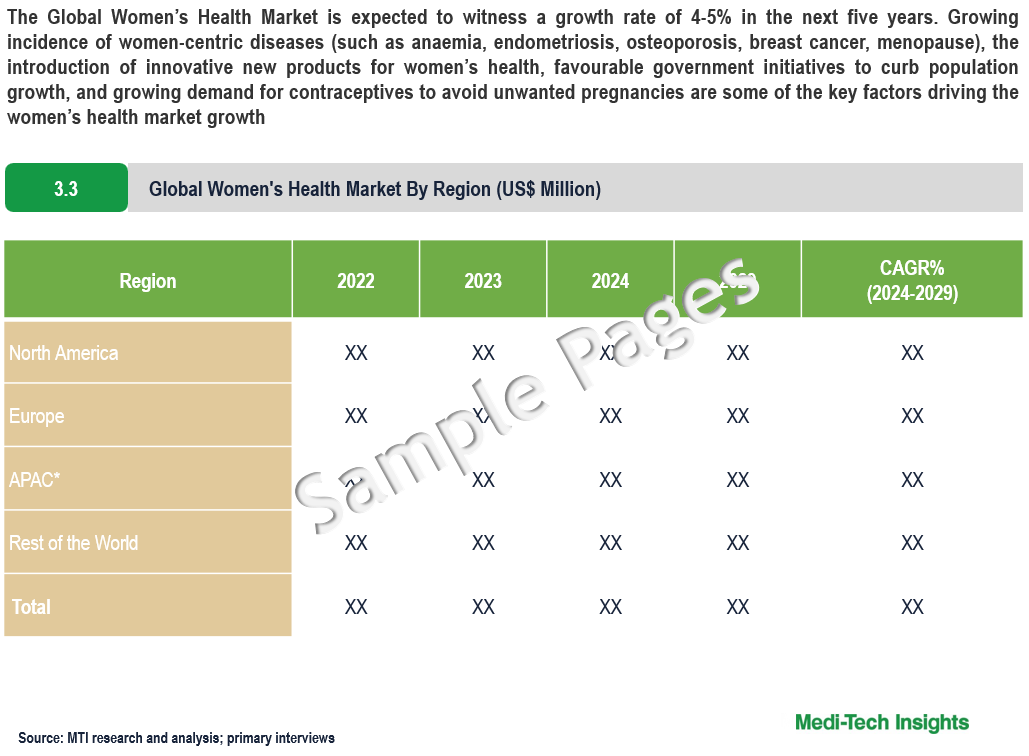
Global Women’s Health Market Size, Share, Trends, Demand and Industry Growth Analysis 2024 to 2029
The Global Women’s Health Market is expected to witness a growth rate of 4-5% in the next five years. Growing incidence of women-centric diseases (such as anaemia, endometriosis, osteoporosis, breast cancer, menopause), the introduction of innovative new products for women’s health, favourable government initiatives to curb population growth, and growing demand for contraceptives to avoid unwanted pregnancies are some of the key factors driving the women’s health market growth. However, adverse effects associated with use of contraceptive drugs and devices, stringent regulatory approvals for new products, and cultural and social barriers is likely to hinder the market’s growth. To learn more about the research report, download a sample report.
One-half of the world’s population is women and they account for ~80% of consumer purchasing decisions in the healthcare industry. Women’s Health is a branch of medicine that focuses on the prevention and treatment of diseases that affect a health. It encompasses a range of drugs for diseases related to women.
Emerging Opportunities in Women’s Health Market
The rising prevalence of infectious and chronic diseases amongst a large group of the female population is a key factor driving the women’s health market. There is great potential to begin addressing these conditions in new ways. Recent advances in genomics, tissue engineering, artificial intelligence, and cell and gene therapy have synergized a new wave of healthcare innovations that can be applied to create products and solutions specific to women's conditions. For example, researchers are studying transcriptomics (the study of RNA molecules in a cell) for treating elusive conditions such as preeclampsia or preterm birth. On the other hand, tissue engineering is being used to create uterine organoids to push the knowledge frontier on endometriosis. Genomics is another research area that can help researchers in realizing the potential of personalized medicine. There has been extraordinary growth in terms of technology from predictive AI solutions to modelling unique DNA profiles which uses machine learning algorithms to analyse user data to provide unique, actionable insights and treatment plans related to symptom progression. A favourable environment for research activities is expected to further drive growth opportunities in this market.
“Women’s health is not a niche market; it includes much more than just maternal or reproductive care. Indeed, women’s healthcare presents enormous opportunities for value creation and for improving the lives and livelihoods of women, with positive effects that redound across society"- Executive Vice President, Global Operations and Supply Chain, Women’s Health Company, United States
Growing incidence of women-centric diseases to Fuel Market Growth
The rising prevalence of women-centric diseases such as anaemia, endometriosis, osteoporosis, breast cancer, and menopause-related conditions is significantly driving the women's health market. As these health disorders become more common, there is an increasing demand for specialized medical services, diagnostic tools, and treatments tailored to women's unique health needs. For instance, there were 2,296,840 new cases of breast cancer in 2022 among women globally. The growing incidence of breast cancer has led to higher demand for mammography and other breast imaging technologies, as well as advanced surgical and pharmaceutical treatments. Endometriosis and osteoporosis require targeted therapies and long-term management, further expanding the market for drugs and medical devices designed specifically for these conditions. Menopause management, including hormone replacement therapies, also sees increased demand as more women seek relief from associated symptoms. Moreover, heightened awareness and early diagnosis initiatives are prompting more women to seek medical attention, contributing to the market's growth. This trend is supported by governmental and non-governmental efforts to improve women's health through education and funding, which enhances access to necessary healthcare services. Consequently, the rising prevalence of these diseases not only emphasizes the need for better healthcare solutions but also propels the overall growth of the women's health market.

To learn more about this report, download the PDF brochure
Growing Demand for Contraceptives to Drive the Women’s Health Market
The growing demand for contraceptives is a significant driver for the women's health market. As awareness about family planning and reproductive health increases, more women are opting for various contraceptive methods to control their fertility and prevent unintended pregnancies. This demand is fueled by educational initiatives, improved access to healthcare services, and a shift towards proactive health management. Contraceptives, including oral pills, intrauterine devices (IUDs), implants, and injectables, offer women the ability to plan their families and careers, contributing to better overall health and economic stability. Additionally, the rise of new and improved contraceptive technologies, such as long-acting reversible contraceptives (LARCs), provides more options that cater to different preferences and needs. Government and non-governmental organizations' efforts to promote contraceptive use and improve accessibility, particularly in developing regions, further bolster this market.
North America Expected to be a Major Growth Engine in Women’s Health Market
North America has the largest women’s health market, followed by Europe and APAC. The large share of North America can be attributed to the strong economies of the US and Canada, established reimbursement policies, early approval & commercialization of products, increased awareness regarding maintaining good health, supportive government regulations, and the presence of key market players in this region. APAC holds a minor share in the global market; however, APAC is expected to witness strong growth in the coming years, due to growing awareness about the importance of women’s health and wellbeing.
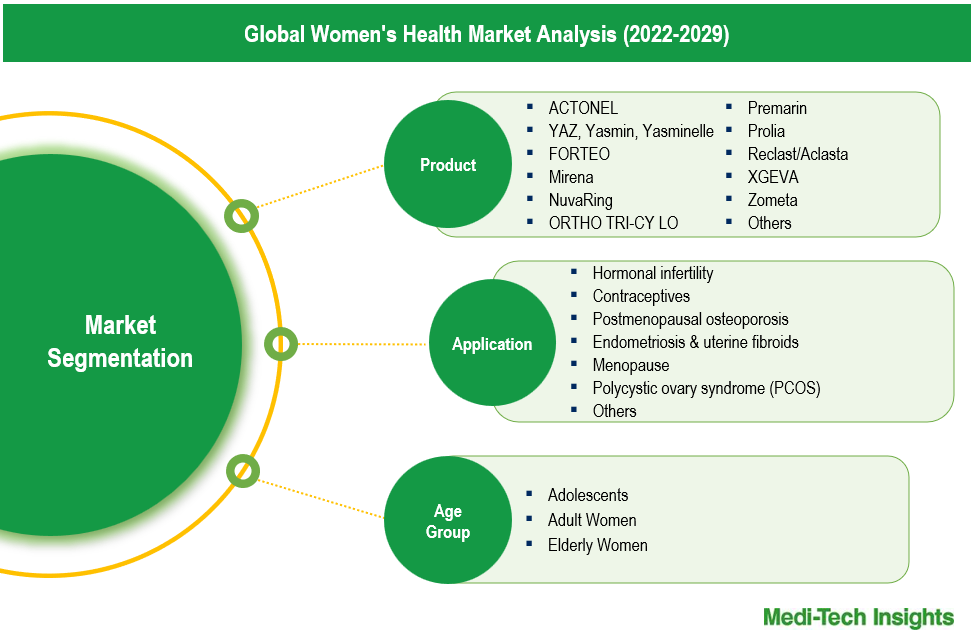
To learn more about this report, download the PDF brochure
Product Type Segment Analysis
The women’s health market comprises two products like: ACTONEL, YAZ (Yasmin, Yasminelle), FORTEO, Mirena, NuvaRing, ORTHO TRI-CY LO, Premarin, Prolia, Reclast/Aclasta, XGEVA, Zometa, Others. The Prolia segment is likely to lead the market and is projected to grow at the fastest rate over the forecast period. Prolia, whose generic name is denosumab, is a medication used in women's health for treating and preventing osteoporosis in postmenopausal women. It is widely used for the treatment of osteoporosis in postmenopausal women at high risk of fractures. Prolia has established a significant market presence due to its effectiveness in reducing the incidence of fractures and its biannual dosing regimen, which improves patient compliance compared to other osteoporosis treatments.
The Minastrin 24 Fe segment is expected to grow at a lucrative CAGR over the forecast period due to its user-friendly dosing schedule and minimal side effects. It combines low-dose estrogen with progestin and iron, which helps manage both birth control and iron deficiency, appealing to women seeking dual benefits. The 24-day active pill regimen, with fewer placebo days, is preferred for its convenience and reduced occurrence of withdrawal bleeding. Additionally, increasing awareness of hormonal contraception's benefits and growing demand for effective, well-tolerated contraceptive options contribute to Minastrin 24 Fe's expanding market presence.
Application Type Segment Analysis
The women’s health market can be analyzed based on application types, such as Hormonal infertility, Contraceptives, Postmenopausal osteoporosis, Endometriosis & uterine fibroids, Menopause, Polycystic ovary syndrome (PCOS), and Others. The contraceptives represent the largest segment. The widespread use of contraceptives for both pregnancy prevention and management of menstrual-related issues drives this large market segment. Contraceptives benefit from extensive awareness, strong demand, and ongoing innovation, which maintains their dominant position. The fastest-growing segment is postmenopausal osteoporosis. The incidence of osteoporosis among postmenopausal women is increasing continuously. This growth is driven by an aging demographic, rising awareness of bone health, and advancements in treatment options. Additionally, increased focus on preventive care and proactive management of bone density is accelerating growth in this area. The combination of a growing patient population and a heightened emphasis on osteoporosis prevention and treatment supports its position as the fastest-growing segment in the women’s health market.
Growth Strategies Adopted by Players to Establish Their Foothold in the Market
Players operating in this market are adopting different growth strategies such as new product launches and approvals to garner market share. For instance,
- In May 2024, The FDA approved Sandoz’s Jubbonti and Wyost as interchangeable biosimilars to Prolia and Xgeva, respectively, for treating certain types of osteoporosis and preventing bone events in cancer. These approvals enhance treatment accessibility and demonstrate the biosimilars' similar safety and efficacy to their reference products
- In January 2024, Bayer Healthcare’s Mirena, a 52mg Levonorgestrel IUD, received FDA approval for contraceptive to extend of this device, for contraception only, to eight years. The approval is particularly beneficial for younger perimenopausal women needing contraception, while the license for treating heavy menstrual bleeding and endometrial protection remains unchanged
- In November 2023, Teva Pharmaceuticals received USFDA of a generic version of Forteo (teriparatide injection) for osteoporosis treatment. This approval enhances patient access to osteoporosis treatment and supports Teva’s goal of maintaining its position as a leading generic pharmaceutical company
The women’s health market is expected to gain further momentum in the coming years due to impending patent cliff, rising R&D investments, new product launches, and aggressive organic and inorganic growth strategies followed by the players.
Competitive Landscape Analysis: Women’s Health Market
The global Women’s Health market is marked by the presence of established market players such AbbVie Inc, Agile Therapeutics, Amgen Inc., Eli Lilly & Company, Pfizer Inc., Merck & Co., Ferring Pharmaceuticals, Mylan N.V., Blairex Laboratories, Apothecus Pharmaceutical, Johnson & Johnson, LUPIN, Bayer AG, Novartis AG, Teva Pharmaceutical Industries Ltd., Organon, Theramex and Allergan, among others.
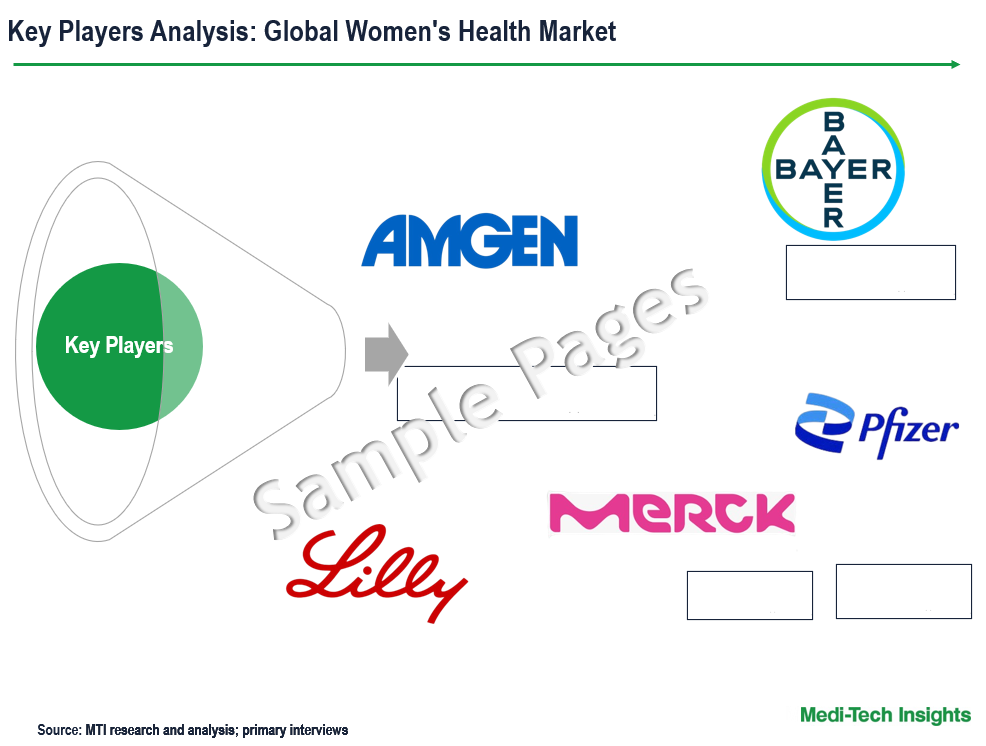
Get a sample report for competitive landscape analysis
Future Outlook of the Women’s Health Market
The global Women’s Health market is expected to gain further momentum in the coming years due to the Enhanced awareness about women's health issues through education campaigns, social media, and government initiatives; advancements in technology and medical research, and increasing government funding and policies aimed at improving women's health. These factors collectively contribute to the growth and evolution of the Women’s Health market.
Women’s Health Market Report Scope
| Report Scope | Details |
| Base Year Considered | 2023 |
| Historical Data | 2022 - 2023 |
| Forecast Period | 2024 - 2029 |
| CAGR (2024-2029) | 4-5% |
| Segment Scope | Product, Application, End User |
| Regional Scope |
|
| Key Companies Mapped | AbbVie Inc, Agile Therapeutics, Amgen Inc., Eli Lilly & Company, Pfizer Inc., Merck & Co., Ferring Pharmaceuticals, Mylan N.V., Blairex Laboratories, Apothecus Pharmaceutical, Johnson & Johnson, LUPIN, Bayer AG, Novartis AG, Teva Pharmaceutical Industries Ltd., Organon, Theramex and Allergan, among others |
| Report Highlights | Market Size & Forecast, Growth Drivers & Restraints, Trends, Competitive Analysis |
Key Strategic Questions Addressed
-
What is the market size & forecast for the Global Women’s Health Market?
-
What are the historical, present, and forecasted market shares and growth rates of various segments and sub-segments of the Global Women’s Health Market?
-
How has COVID-19 impacted the Global Women’s Health Market?
-
What are the major growth drivers, restraints/challenges impacting the market?
-
What are the opportunities prevailing in the market?
-
What is the investment landscape?
-
Which region has the highest share in the global market? Which region is expected to witness the highest growth rate in the next 5 years?
-
Who are the major players operating in the market? What is the competitive positioning of key players?
-
Who are the new players entering the market?
-
What are the key strategies adopted by players?
- Research Methodology
- Introduction
- Market Scope
- Market Definition
- Segments Covered
- Regional Segmentation
- Research Timeframe
- Currency Considered
- Study Limitations
- Stakeholders
- List of Abbreviations
- Key Conferences and Events (2023-2024)
- Research Methodology
- Secondary Research
- Primary Research
- Market Estimation
- Bottom-Up Approach
- Top-Down Approach
- Market Forecasting
- Executive Summary
- Women’s Health Market Snapshot (2023-2029)
- Segment Overview
- Regional Snapshot
- Competitive Insights
- Market Overview
- Market Dynamics
- Drivers
- Growing incidence of women-centric diseases
- Introduction of innovative new products for women’s health
- Favourable government initiatives to curb population growth
- Growing demand for contraceptives to avoid unwanted pregnancies
- Restraints
- Adverse effects associated with use of contraceptive drugs and devices
- Stringent regulatory approvals for new products
- Cultural and social barriers
- Opportunities
- Emerging Markets
- Personalized medicine
- Key Market Trends
- Focus on preventive healthcare
- Collaborations and Partnerships
- Industry Speaks
- Drivers
- Market Dynamics
- Key Revenue Pockets
- Global Women’s Health Market - Size & Forecast (2022-2029), By Product Type
- ACTONEL
- YAZ, Yasmin, Yasminelle
- FORTEO
- Mirena
- NuvaRing
- ORTHO TRI-CY LO
- Premarin
- Prolia
- Reclast/Aclasta
- XGEVA
- Zometa
- Others
- Global Women’s Health Market - Size & Forecast (2022-2029), By Application Type
- Hormonal infertility
- Contraceptives
- Postmenopausal osteoporosis
- Endometriosis & uterine fibroids
- Menopause
- Polycystic ovary syndrome (PCOS)
- Others
- Global Women’s Health Market - Size & Forecast (2022-2029), By Age Group Type
- Adolescents
- Adult Women
- Elderly Women
- Global Women’s Health Market - Size & Forecast (2022-2029), By Region
- Introduction
- North America Women’s Health Market Size & Forecast (2022-2029), By Country, USD Million
- US
- Market Size & Forecast, By Product Type (USD Million)
- Market Size & Forecast, By Application Type (USD Million)
- Market Size & Forecast, By Age Group Type (USD Million)
- Canada
- Market Size & Forecast, By Product Type (USD Million)
- Market Size & Forecast, By Application Type (USD Million)
- Market Size & Forecast, By Age Group Type (USD Million)
- Europe Women’s Health Market Size & Forecast (2022-2029), By Country, USD Million
- UK
- Market Size & Forecast, By Product Type (USD Million)
- Market Size & Forecast, By Application Type (USD Million)
- Market Size & Forecast, By Age Group Type (USD Million)
- Germany
- Market Size & Forecast, By Product Type (USD Million)
- Market Size & Forecast, By Application Type (USD Million)
- Market Size & Forecast, By Age Group Type (USD Million)
- France
- Market Size & Forecast, By Product Type (USD Million)
- Market Size & Forecast, By Application Type (USD Million)
- Market Size & Forecast, By Age Group Type (USD Million)
- Italy
- Market Size & Forecast, By Product Type (USD Million)
- Market Size & Forecast, By Application Type (USD Million)
- Market Size & Forecast, By Age Group Type (USD Million)
- Spain
- Market Size & Forecast, By Product Type (USD Million)
- Market Size & Forecast, By Application Type (USD Million)
- Market Size & Forecast, By Age Group Type (USD Million)
- Rest of Europe
- Market Size & Forecast, By Product Type (USD Million)
- Market Size & Forecast, By Application Type (USD Million)
- Market Size & Forecast, By Age Group Type (USD Million)
- Asia Pacific (APAC) Women’s Health Market Size & Forecast (2022-2029), By Country, USD Million
- China
- Market Size & Forecast, By Product Type (USD Million)
- Market Size & Forecast, By Application Type (USD Million)
- Market Size & Forecast, By Age Group Type (USD Million)
- Japan
- Market Size & Forecast, By Product Type (USD Million)
- Market Size & Forecast, By Application Type (USD Million)
- Market Size & Forecast, By Age Group Type (USD Million)
- India
- Market Size & Forecast, By Product Type (USD Million)
- Market Size & Forecast, By Application Type (USD Million)
- Market Size & Forecast, By Age Group Type (USD Million)
- Rest of Asia Pacific
- Market Size & Forecast, By Product Type (USD Million)
- Market Size & Forecast, By Application Type (USD Million)
- Market Size & Forecast, By Age Group Type (USD Million)
- Latin America (LATAM) Women’s Health Market Size & Forecast (2022-2029), USD Million
- Market Size & Forecast, By Product Type (USD Million)
- Market Size & Forecast, By Application Type (USD Million)
- Market Size & Forecast, By Age Group Type (USD Million)
- Middle East & Africa (MEA) Women’s Health Market Size & Forecast (2022-2029), USD Million
- Market Size & Forecast, By Product Type (USD Million)
- Market Size & Forecast, By Application Type (USD Million)
- Market Size & Forecast, By Age Group Type (USD Million)
- China
- UK
- US
- Competitive Landscape
- Key Players and their Competitive Positioning
- Competitive Positioning of Key Players (2023)
- Offerings Assessment, By Player
- Key Strategies Assessment, By Player (2022-2024)
- New Product & Service Launches
- Partnerships, Agreements, & Collaborations
- Mergers & Acquisitions
- Geographic Expansion
- Key Players and their Competitive Positioning
- Key Companies Scanned (Indicative List)
- AbbVie Inc
- Agile Therapeutics
- Amgen Inc.
- Eli Lilly & Company
- Pfizer Inc.
- Merck & Co.
- Ferring Pharmaceuticals
- Mylan N.V.
- Blairex Laboratories
- Apothecus Pharmaceutical
- Johnson & Johnson
- LUPIN
- Bayer AG
- Novartis AG
- Teva Pharmaceutical Industries Ltd.
- Organon
- Theramex
- Allergan
- Other Prominent Players
The study has been compiled based on extensive primary and secondary research.
Secondary Research (Indicative List)
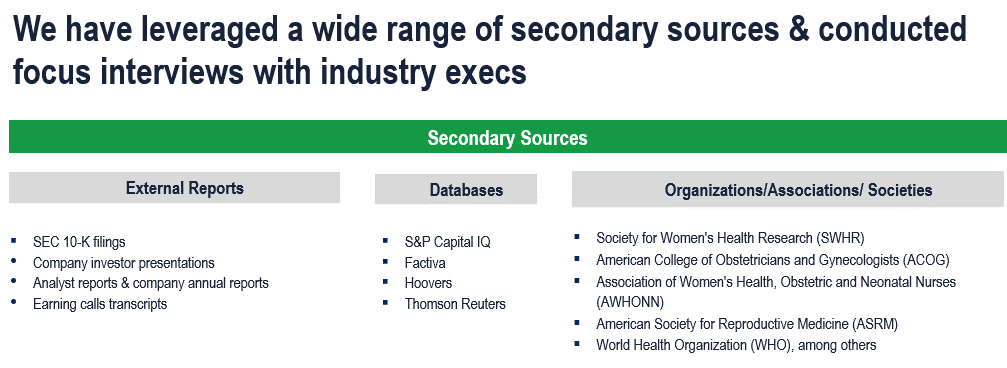
Primary Research
To validate research findings (market size & forecasts, market segmentation, market dynamics, competitive landscape, key industry trends, etc.), extensive primary interviews were conducted with both supply and demand-side stakeholders.
Supply Side Stakeholders:
- Senior Management Level: CEOs, Presidents, Vice-Presidents, Directors, Chief Technology Officers, Chief Commercial Officers
- Mid-Management Level: Product Managers, Sales Managers, Brand Managers, Business Development Managers, Consultants
Demand Side Stakeholders:
- Stakeholders in Hospitals, ASCs and Clinics, Obstetricians, Gynaecologists, Oncologists and Others
Breakdown of Primary Interviews
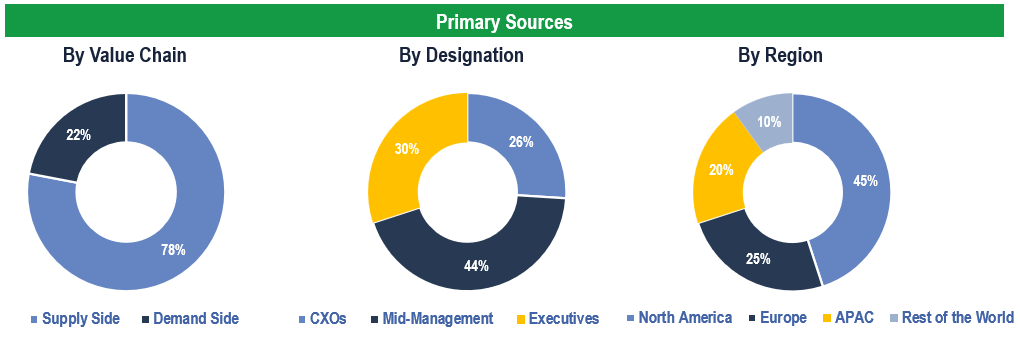
Market Size Estimation
Both ‘Top-Down and Bottom-Up Approaches’ were used to derive market size estimates and forecasts.
Data Triangulation
Research findings derived through secondary sources & internal analysis were validated with Primary Interviews, Internal Knowledge Repository, and Company Sales Data.

